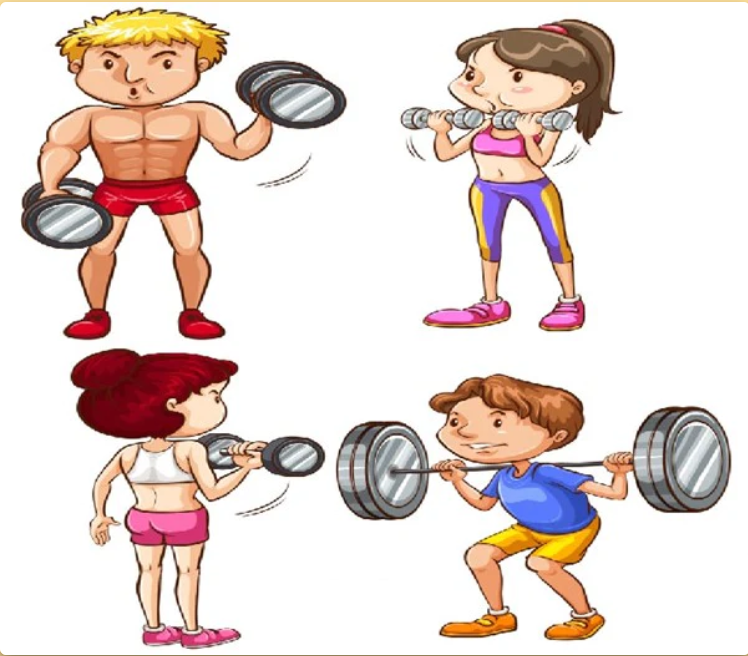Deadlifts are the king of all exercises.
They exercise a wide range of muscles:
CLENBUTROL Natural Alternative for Cutting & Lean Muscle Supplement, FIRST TIME IN INDIA
1. Standard Deadlift
Ideal For: Shorter lifters
Have you ever noticed that in deadlift powerlifting competitions, lifters shorter than 5’7″ always win first place? An individual may perform a conventional deadlift more easily the shorter they are. 5 Kinds of Deadlifts for Different Body Types
Compared to a tall individual, athletes with short legs will find it much simpler to crouch down and grip the bar. Additionally, taller lifters have a propensity towards arching their backs during a deadlift. If beginners are not careful, they may even suffer a back injury.
Those with short legs also have a restricted range of motion. You can lift heavier weights thanks to this without having to put in a lot of effort.
How to:
- With your feet shoulder-width apart, your hands by your sides, your back straight, and your eyes fixed front, stand in front of a weighted barbell.
- Grab the bar tightly and maintain a straight back while squatting until the knees are at a 90-degree angle. Use a mixed, underhand, or overhand grip as you’d like.
- Driving the heels into the ground and straightening the legs can help you lift the barbell while maintaining a straight back and forward gaze.
- When you reach the peak, lean your body back slightly, hold, and then gradually lower the weight back down.

5 Kinds Of Deadlifts For Different Body Types
2. SUMO DEADLIFT
Ideal For: Lifters with long arms and short legs
One of the most well-liked deadlift variations used by bodybuilding and powerlifting athletes to strengthen their hamstrings and glutes is the sumo deadlift. Its broad stance sets it apart from conventional deadlifts.
A broader foot stance causes the inner thighs and glutes to bear the majority of the weight instead of the quadriceps. Because of this, it’s a great move for lifters who want to concentrate on certain regions.
Athletes will be able to lift a larger load than they typically can since sumo deadlifts have a narrower range of motion than standard deadlifts.
Sumo deadlifts are a sort of deadlift that anyone can perform, although people with long arms and short legs who regularly exercise in the gym tend to benefit the most from them. One can dive deeper without excessively arching their back by using this leg-to-arm ratio.
Conversely, short-armed lifters could find it challenging to complete this motion.
How to:
- Standing straight and with your feet wider than shoulder-width apart in front of a weighted barbell, your back should be straight, your arms should hang down the middle of your body, and your toes should point outward.
- Then, kneel down by bending your knees, and grab the bar with whichever grip feels most comfortable. leg-to-arm
- Slowly raise the barbell by extending your legs and planting your heels firmly on the floor. Maintain a straight back and forward gaze.
- When you reach the peak, pause for one count before gradually lowering the weight back down.
- Perform 3 to 4 sets of 10 to 12 repetitions.
3. HEX BAR DEADLIFTS

Ideal For: Tall lifters
Deadlifting typically causes lower back pain for taller athletes, those over 6’2″. When they lean down to hoist the bar off the ground, their long body places too much strain on their pelvic.
However, it is preferable to utilise a hex bar when performing regular deadlifts for tall people.
Because of the handles, you can hold the bar without arching your back or putting undue strain on your pelvic when you squat down to do so.
How to:
- Keep your back straight, fix your eyes forward, spread your feet shoulder-width apart, and let your arms hang at your sides while you stand in the middle of a loaded hex bar.
- While keeping your back straight, squat down by bending your knees. Next, take a neutral hold with your palms towards your body and grasp the side bars.
- After then, straighten your legs and push the weight off the ground by pressing your heels into the ground.
- When you reach the top, pause, then gradually bring the weight back down.
4. RACK PULLS
Ideal For: lifters with short arms and long legs
Long-legged athletes are aware of how difficult it is to squat to the proper deadlift posture. Either the back arches forward or the knees swivel out. Both the legs and the back suffer greatly in any case.
The weighted barbell can fortunately be placed on a power rack to rapidly fix this. Long-legged lifters can grab the barbell and position their bodies more easily by raising the barbell.
For tall powerlifters without access to a hex bar quite yet, this serves as a backup plan.
How to:
CLENBUTROL Natural Alternative for Cutting & Lean Muscle Supplement, FIRST TIME IN INDIA (90 Capsules)
- The bar should be placed directly below the knee and the barbell should be placed on the power rack.
- With your feet shoulder-width apart, your back straight, your knees bent at a 90-degree angle, and your hands holding the bar in either grip, squat down.
- Driving the heels into the ground and straightening the legs can help you lift the barbell while maintaining a straight back and forward gaze.
- When you reach the peak, lean your body back slightly, hold, and then gradually lower the weight back down.
5. ROMANIAN DEADLIFTS
Ideal For: Those who lift with weak glutes and hamstrings
Although barbell squats are excellent, leg day involves more than just quad conditioning. Lifters should also focus on their glutes and hamstrings if they want to develop true lower body strength and growth.
These muscles are essential to athletes in order for them to move more quickly and sprint farther. Bodybuilders can utilise Romanian deadlifts to develop a lower body that is better proportional and well-balanced.
How to:
- With your feet shoulder-width apart, your back straight, your arms at your sides, and your gaze fixed front, stand in front of a barbell.
- Next, take an overhand hold of the bar, place your hand on top of it, and lift it off the ground. The burden ought to rest slightly below the waist.
- Next, carefully push the hips back as though reaching out to touch the wall with the butt. Lock your eyes forward and maintain a straight back as you do this.
- When you pause, bring your hips back to the starting position.






